If you want to capitalize on your company and workers’ knowledge, you have to find a way to manage it.
Through good knowledge management (KM), you’ll ensure the achievement of your knowledge goals.
But, successful KM is a lot more than saving files in the same folder and hoping for the best.
It’s a system that encourages people to participate, lets them search and find information quickly, and offers current and correct data.
So, if you’re in charge of KM at your company but don’t know where to start or which strategy would work best, we’re here to help.
Let’s dive right into seven different KM strategies!
Motivating for Desired Behaviors
One of the best strategies is motivating people to share their knowledge.
If you just tell workers they should contribute to your internal knowledge base (KB) because it can help others, many might not want to do it.
Writing down your insights and sharing them with others takes time, but you get little in exchange for your work.
But, if you motivate the workers by offering incentives, many will participate in your company’s knowledge-sharing culture.
Although this may seem obvious, many companies still don’t get it right. APQC survey shows that only 11% of employees think their company’s attempts to motivate or incentivize them to take part in KM are effective or very effective.
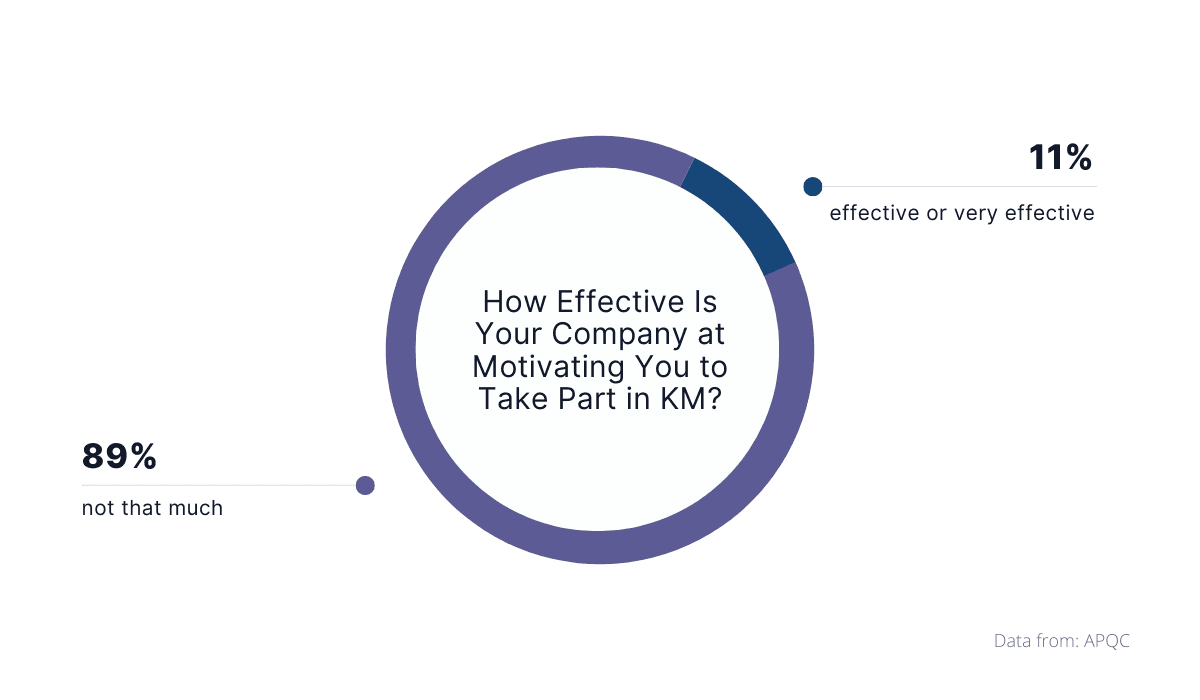
Source: Archbee
The key to effectiveness might be offering people what they want.
Stan Garfield, a KM expert, agrees that incentives and rewards are a great way to get people to contribute with their insights.
But, you have to do it right. In his article, Garfield lists a couple of potential rewards you can offer, such as:
- Performance ratings
- Salary increases
- Promotion requirement
- Tangible rewards, such as financial incentives
In other words, you should embed your strategy into every part of your company, including employee performance reviews.
Your team should know their involvement in KM will reflect their performance, bonuses, and overall work. They need to understand that sharing knowledge pays off more than holding onto it.
Shatha Al Maskiry, a business consultant, thinks incentives are the way to go in this case, too.

Source: Twitter
For example, to encourage people to contribute to your knowledge base, you can reward those who do it often by increasing their salaries or giving them bonuses.
In other cases, you can use rewards such as gift cards, app subscriptions, or company goodies to thank the employees for being a part of your KM strategy and sharing their knowledge with others.
If you don’t think monetary prizes are the way to go, you can follow Nick Milton’s advice and motivate people by acknowledging and praising their contributions.
Encouraging Networking Through Collaboration
Collaboration is a great way to get people to share knowledge.
The easiest way is to simplify contacting coworkers. If one of your workers needs to consult an expert, they should be able to find contact information in your knowledge base.
Conversations should be easy if everyone in your company uses the same social software like Slack or Microsoft Teams.
Apps like these allow employees to easily chat or set up meetings with anyone from the company who has an account.
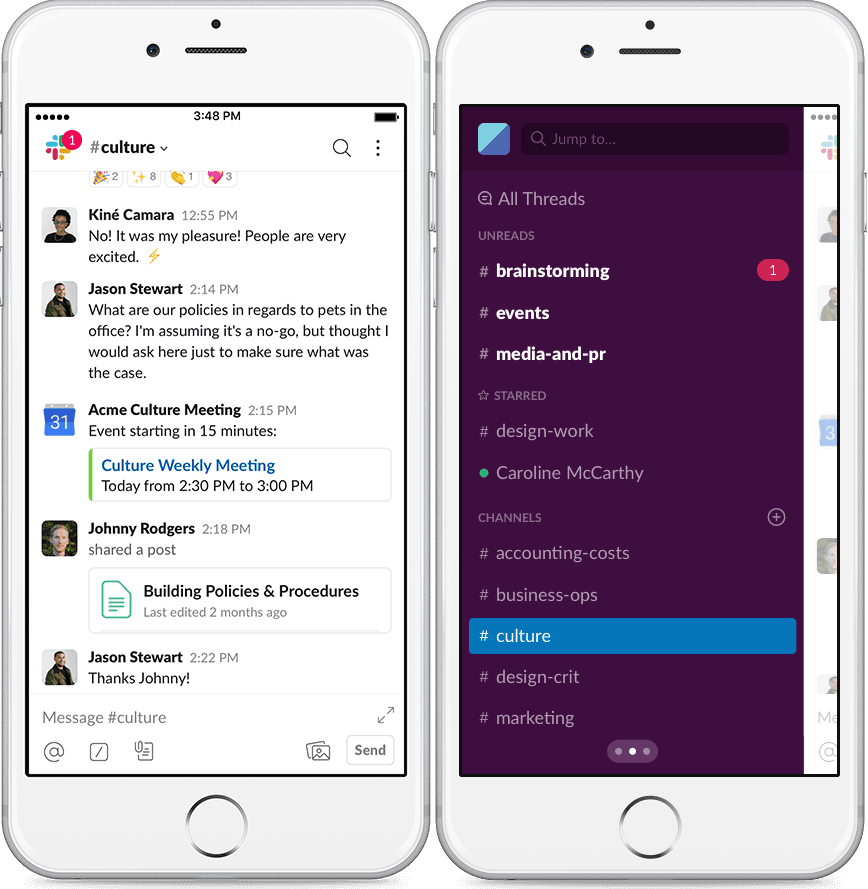
Source: Slack
The easier you make it for team members to contact each other, the more you promote collaboration.
Through these meetings and conversations, your team will continue to use their knowledge to get better results and more advanced ideas.
In fact, group brainstorming allows people to share even impractical ideas and use other people’s input to improve the end solution, which further motivates them to participate.
If your team still isn’t comfortable enough with sharing their opinions, you can always find a way to do it anonymously.
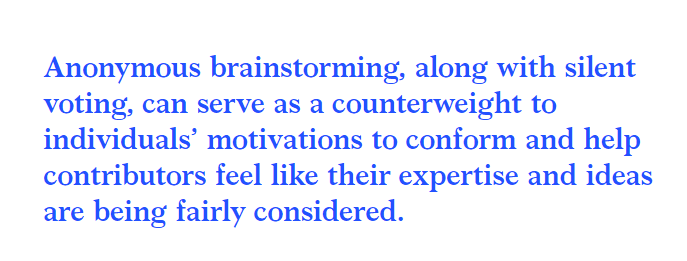
Source: McKinsey
According to experts at McKinsey, anonymous brainstorming helps people share their insight because of the fairness of the setup.
The bosses don’t know who suggested something, so an idea is judged only on how good it is. Whether anonymous or not, collaboration always reaps results.
The consulting companies that promote collaboration between consultants are an excellent example of this.
For instance, HBR explains that Bain & Company, a management consulting company, uses a personalized knowledge strategy for their KM.
Instead of relying solely on written instructions from a KB, the company pushes for collaboration and dialogue so their employees can share all the personalized knowledge they have.
You can boost this through software that allows users to comment on posts and ask questions.
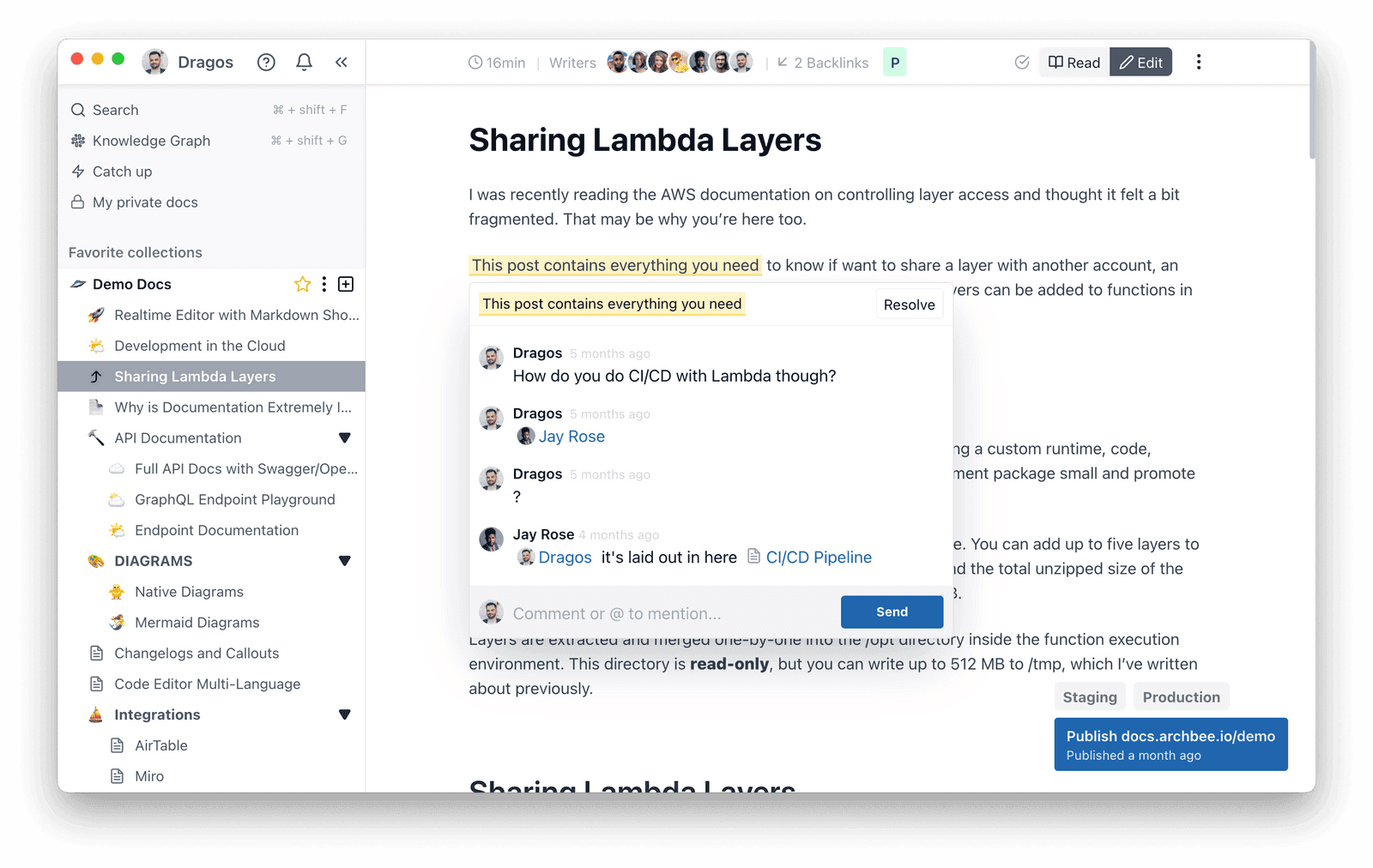
Source: Archbee
Marcia Blenko from Bain & Co had to help a financial institution by offering them new products and services.
Since she didn’t have much experience with it, Blenko turned to her colleagues for help. She already knew employees with expertise in that field, but Blenko also used the company’s database to find additional contacts.
The consultant had video calls and met some of these experts to collect their knowledge and find the best strategy for her client.
That way, she combined her own experience and the expertise of her coworkers to come up with the best solution.
Supplying the Knowledge
If you want to know whether your KM strategy works, just consider how easy it is to find and use the provided information.
The key to a good strategy is collecting knowledge and translating it into something that you can upload and share with the team.
For example, if you use some of the best tools designed to help you gather and share knowledge, you’ll have an easier time managing it.
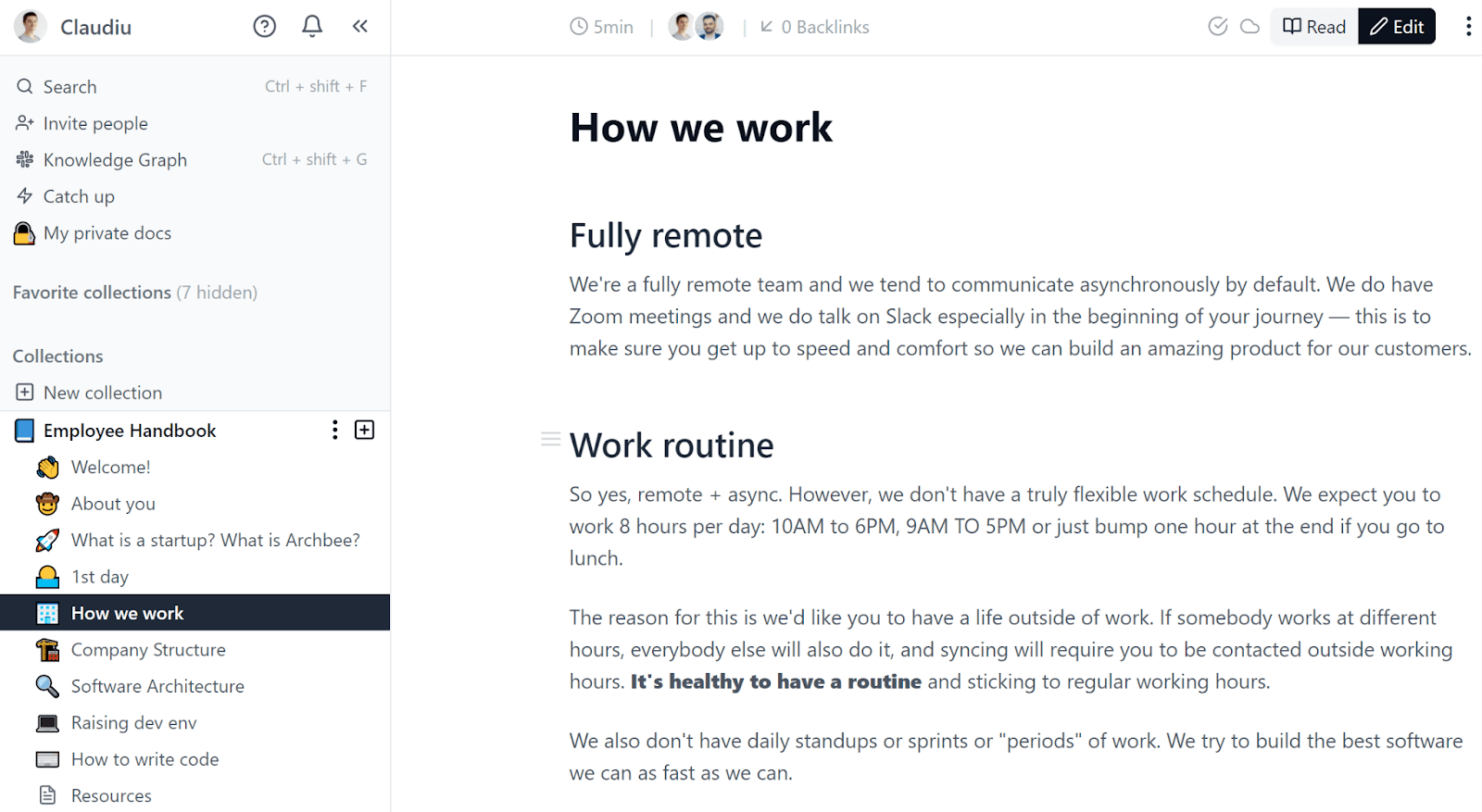
Source: Archbee
On the other hand, if you save your files in a shared folder, the information won’t be as accessible to everyone, and the searching option won’t be as advanced.
You need a good KM tool that will help you store all this knowledge in the same place and make it accessible to everyone who needs it.
The readers don’t necessarily have to be your employees. Your clients could get helpful information regarding your products and services through a good KB, including FAQs and troubleshooting.
However, if all these people use your KB, you have to make navigation easy. People often waste a lot of time on unoptimized websites trying to find the information they need.
You don’t want your KB to be one of those places, so you should use software with features like a search bar, search analytics, and knowledge graphs.
All these options make it easy for visitors to locate the data they’re interested in quickly.

Source: Archbee
When it comes to the knowledge supply, you should encourage your team to contribute. A great way to do this is to make uploading their work and sharing it with others a regular part of their process.
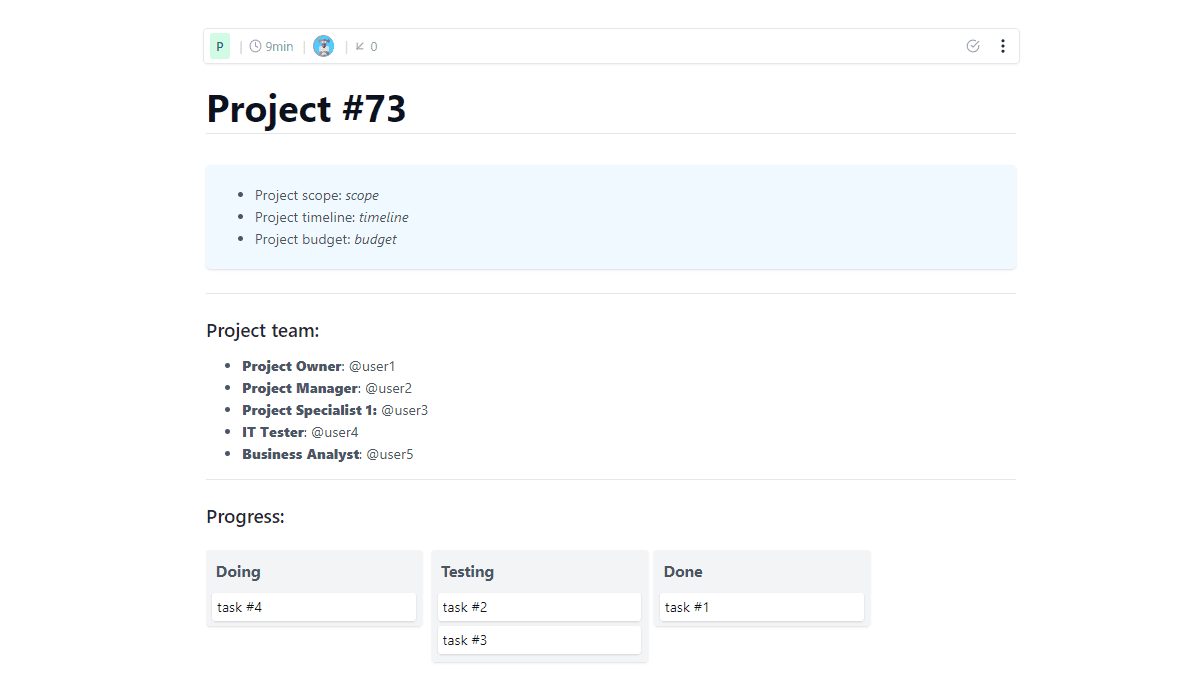
Source: Archbee
For example, if you have a project team, you can ask them to share all the project documentation in your KB.
They will then upload every document relating to the project, including project plans, decisions, budget, and every aspect you think others can learn from and improve.
Analyzing Gathered Information
A successful knowledge-sharing system is one where the information is accurate and up-to-date.
Even if your knowledge base consists of a plethora of data submitted by experts in the field, it might not be as valuable as you might think.
When someone shares data with you and writes KB articles, you need to analyze them before publishing.
Why? Some of the data might be confidential, which means not all employees and visitors should see it.
Quality KM software will help you grant or restrict access to employees and visitors alike, making it easier to protect the files you deem confidential.
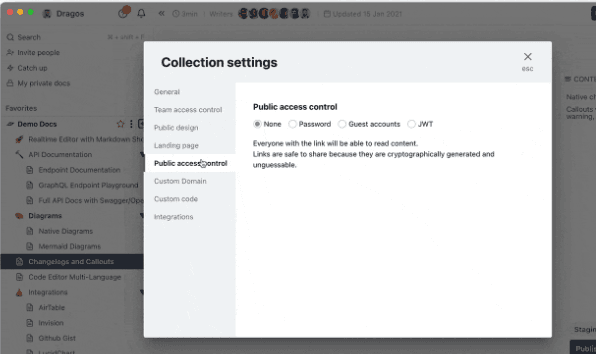
Source: Archbee
Then, some information might not even be helpful and is therefore just clogging your knowledge base.
Without a content analysis, you’ll just post whatever your team submits, which might overwhelm visitors.
Of course, there could be documents that are older versions of other files or that repeat many times in different KB spaces.
You should analyze the content in detail to decide which parts of it can stay and benefit your team and which should be private, restricted, or deleted.
Good KB software like Archbee will let you verify content, which is a big part of knowledge analysis.
You can assign someone with significant knowledge on a topic to check related content periodically and ensure it’s still correct.
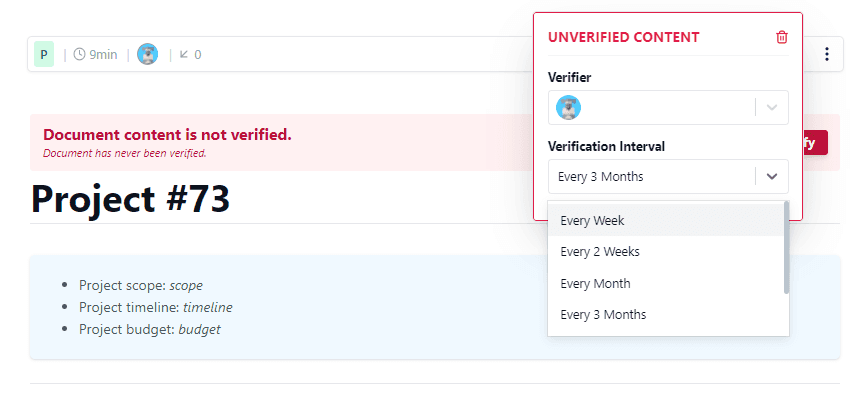
Source: Archbee
This option not only shows the team that an expert checked and approved the content but how often the expert usually does it.
That way, you create an extra layer of assurance in the validity of available data.
The team will know how long ago an expert checked the document out and will be able to determine whether they can rely on the data at hand.
Codifying Information Into Structured Content
Codifying your company knowledge will do wonders for the usability of the entire knowledge base.
In simpler terms, it’s the process of turning tacit into explicit knowledge, i.e., capturing and writing down the employees’ insights.
Once codified, the data is categorized, searchable, easily tagged, and cataloged. Companies do all of this to make the best of their workers’ knowledge.
Ralph Poole, former director of Ernst & Young’s Center for Business Knowledge, describes the process like this:
“After removing client-sensitive information, we develop ‘knowledge objects’ by pulling key pieces of knowledge such as interview guides, work schedules, benchmark data, and market segmentation analyses out of documents and storing them in the electronic repository for people to use.”
The 250 people at the company’s Center for Business Knowledge manage the electronic repository and help consultants find and use necessary information.
An employee from the LA office hadn’t yet worked on a manufacturing project when he was given one.
However, he knew other Ernst & Young teams had, so he searched the electronic knowledge management repository for relevant knowledge and finished his project successfully, backed by the knowledge and expertise of more experienced coworkers.
Bain & Company’s former Vice President and Director, Mark Horwitch, and Robert Armacost, former Director of Knowledge Management, think that the company should distribute and broker knowledge.
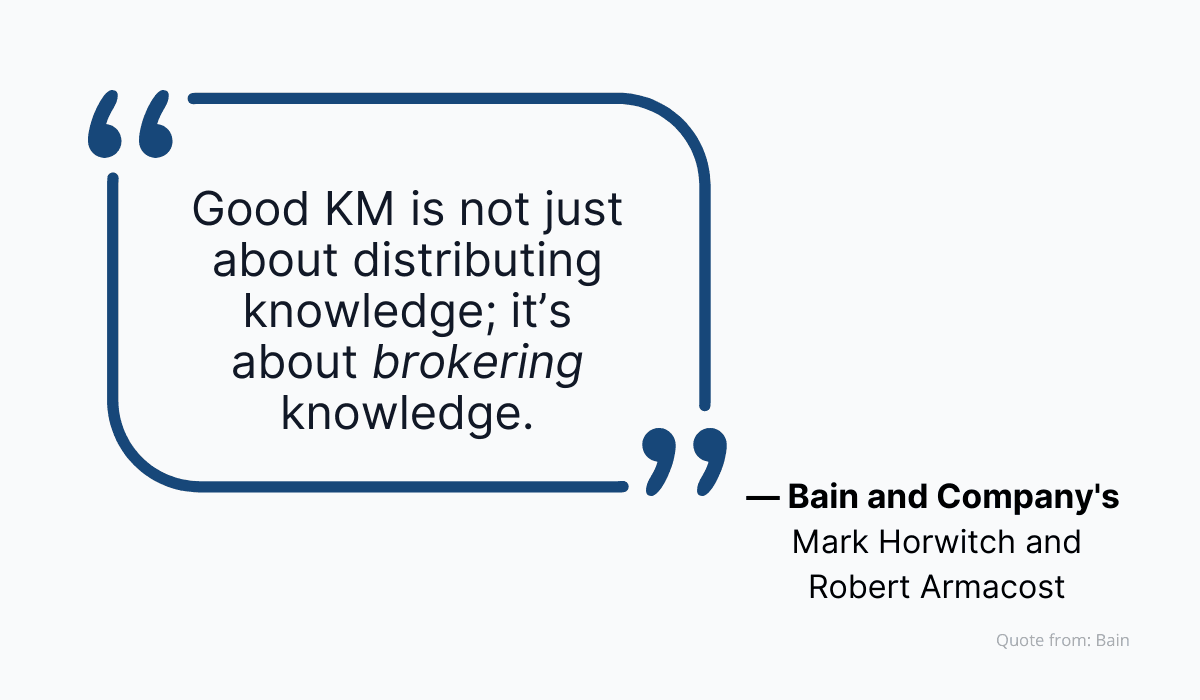
Source: Archbee
According to them, a company should invest time, people, and resources into gathering and sharing “the right information at the right times.”
It’s these people who codify the data into something reusable.
Bain and Company hire people to manage knowledge, including gathering and codifying it.
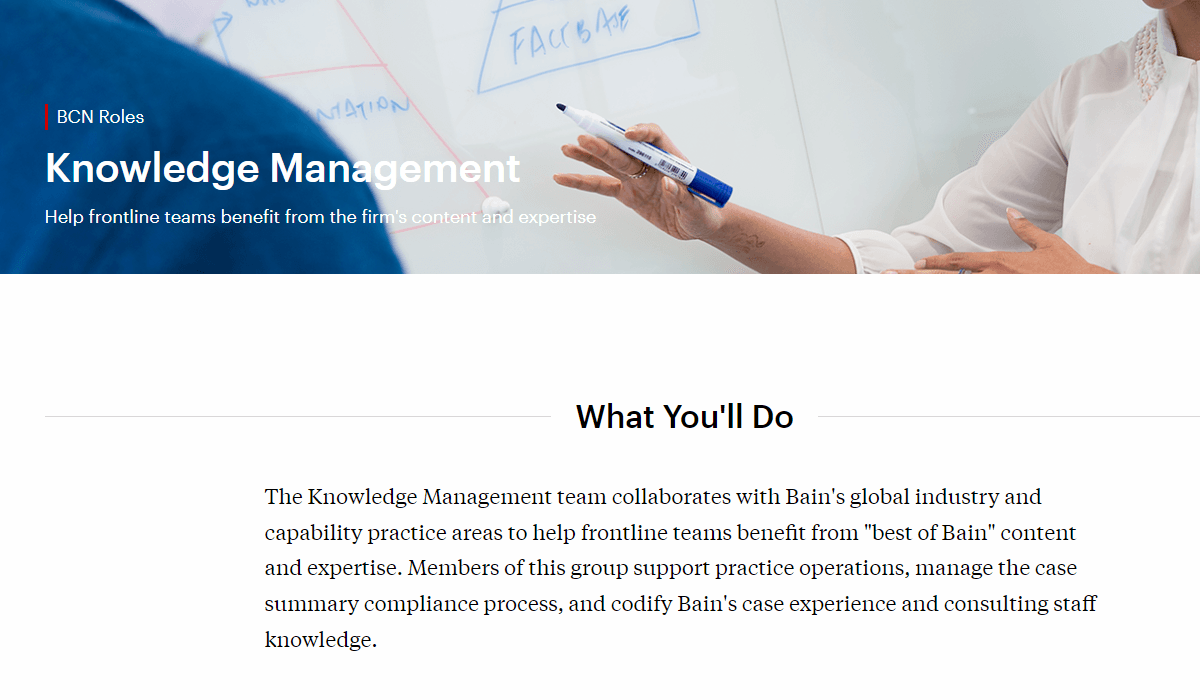
Source: Bain
More precisely, the company explains that the KM team reads up on the previous cases and solutions and collaborates with the consultants to decide what information to include.
Then, they transfer the detailed information into something other employees can apply in their cases and everyday work.
Disseminating the Valuable Knowledge
Another effective KM strategy ensures you share the analyzed and codified knowledge with your team and clients.
Having all that knowledge stored on a company server is practical, but you should make sure people know how to get to it.
What better way to achieve that than to send them links to articles, give them access to the database, and notify them of all updates?
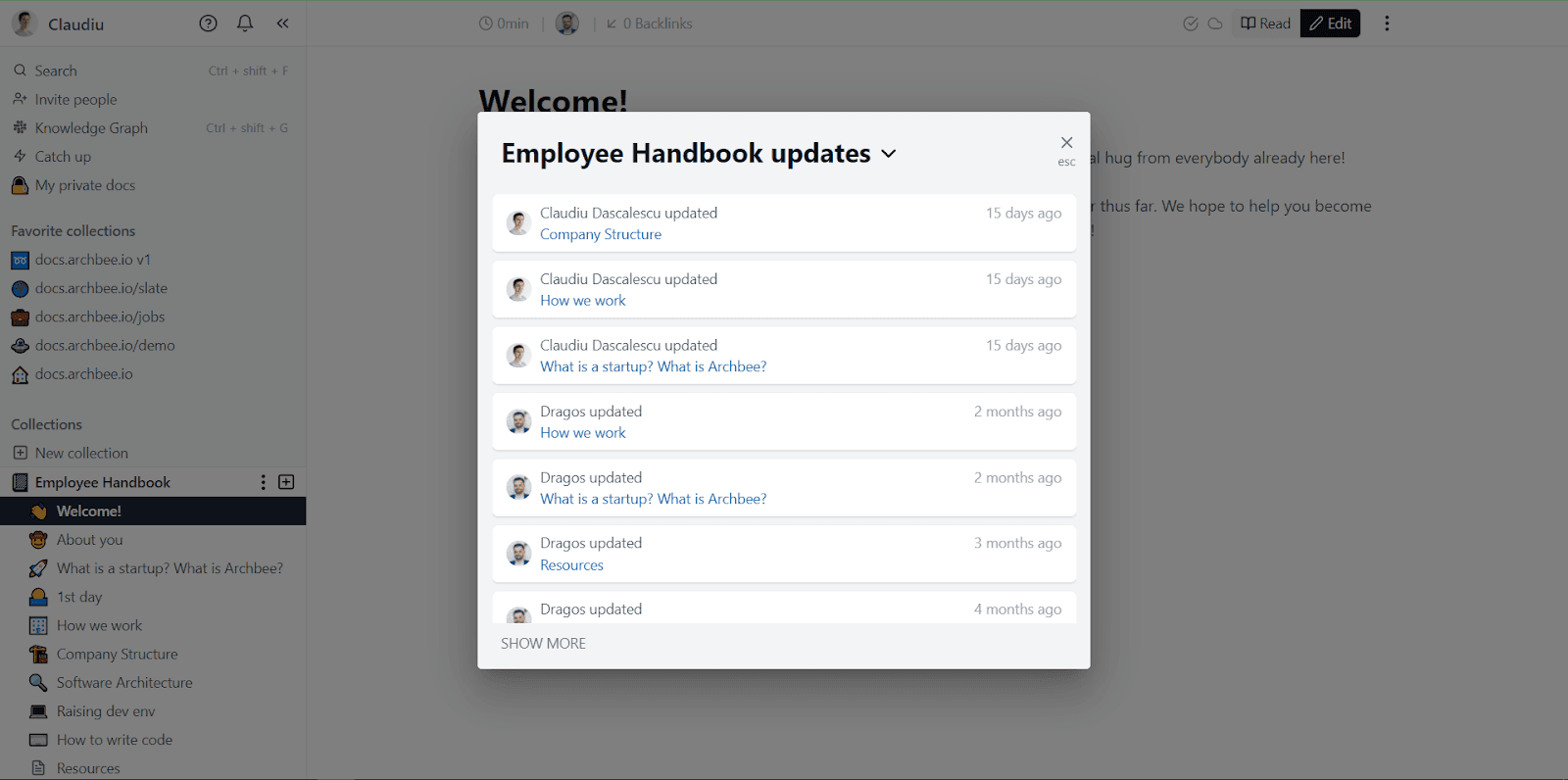
Source: Archbee
How does your team get updates now? Chances are it’s through emails.
You or the managers write down the necessary details and send them to the entire team, thinking you’ve informed everyone of the changes.
However, McKinsey’s research found that employees spend almost a third of their workweek reading and answering emails. Because of this, many of them don’t even read most of the emails.
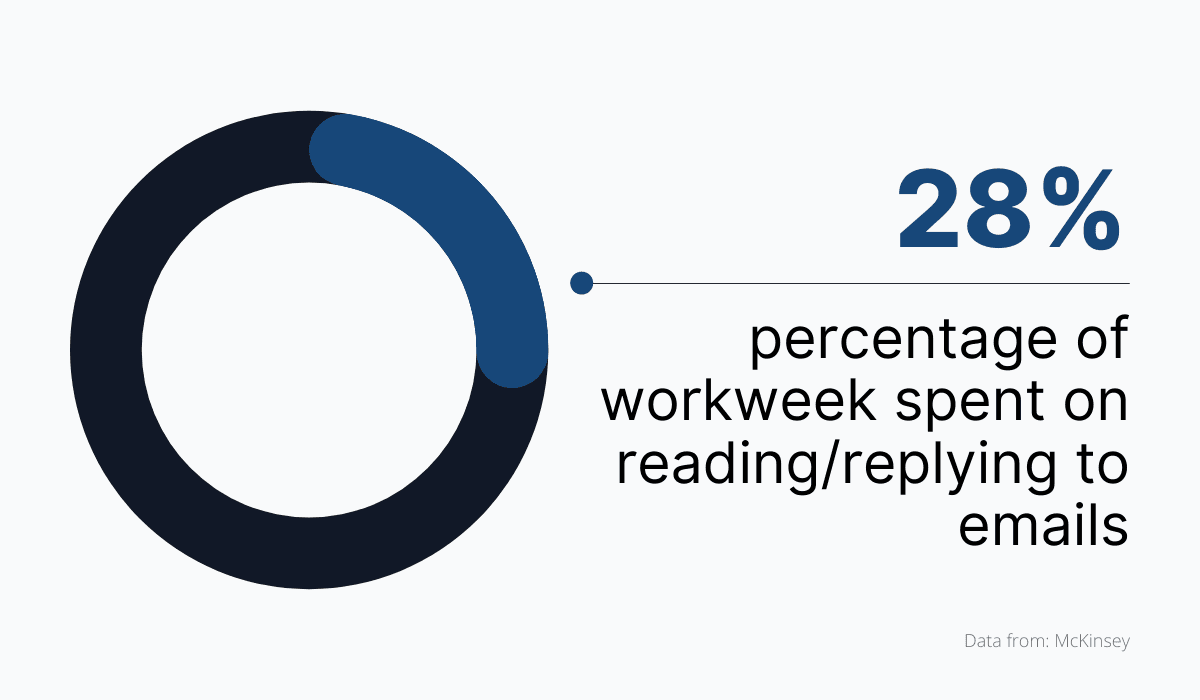
Source: Archbee
So, you’ll have to find something more accessible and not as cumbersome as email. The social software your employees already use to communicate with colleagues is the optimal solution.
It’s a tab or app they always have open, so you’re sure the information will reach them fast.
Good KM software like Archbee offers different integrations, which means you’ll get updates and notifications through apps you usually use to do business.
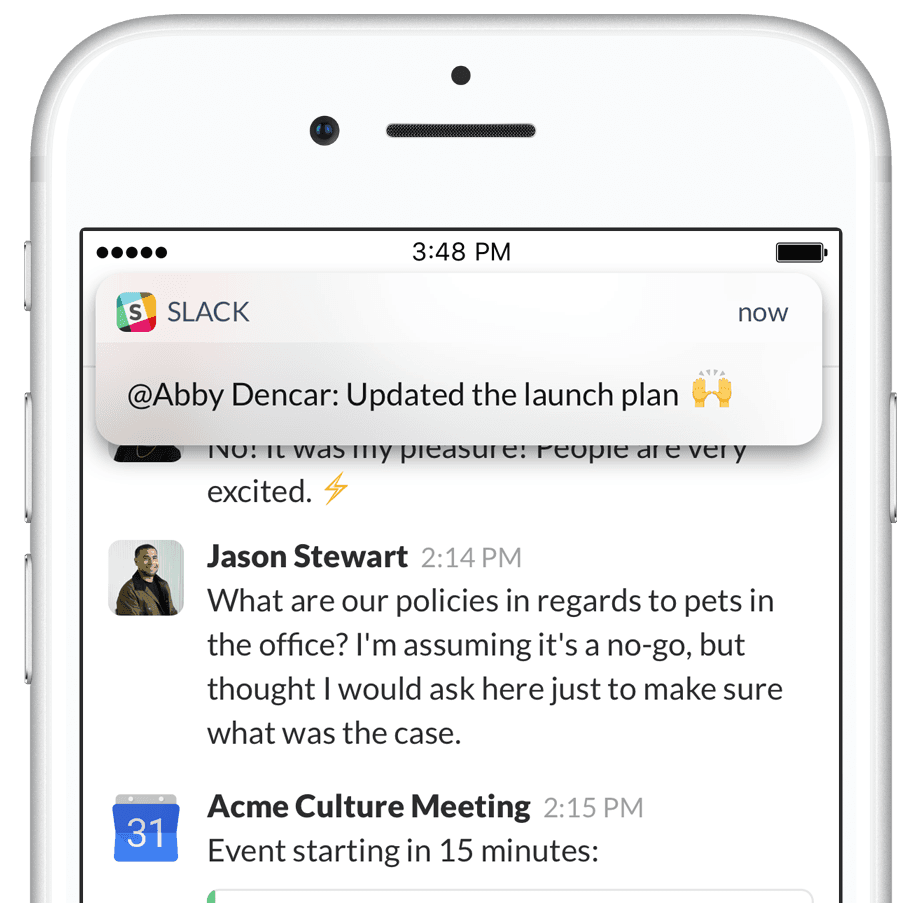
Source: Slack
For example, if your team uses Slack to communicate, the integration will let you notify your team members when you add or update files. That’s a lot easier than email and doesn’t clog their inboxes.
Demanding New Knowledge
It’s always a good idea to create a culture of knowledge sharing.
Employees who aren’t afraid to ask for more information will significantly benefit your KM, especially since you’ll realize where your current KM system lacks.
To get to the point where your team members can freely demand knowledge, you should cultivate a company culture that inspires workers to ask and respond to questions.
Therefore, your current culture should change into one that motivates and promotes the exchange of ideas and information.
However, a strategy that revolves around acquiring new knowledge includes keeping existing content up to date. People who visit your knowledge base need to be able to rely on the data being correct.

Source: Archbee
If you encourage people to demand the information they need, their needs have to reach you. Otherwise, their information needs will not be met.
With software like Archbee, you’ll get insights into your KB visitors' searches because of the search analysis option.
The software will show you what queries people entered into the search bar and how many results they got.

Source: Archbee
This feature allows you to understand which knowledge is missing from the KB.
If people are searching for something, but your KB offers zero results, they’re either completely missing the mark with the keywords they’re using, or you don’t have knowledge base articles that cover the topic.
In the latter case, it’s up to you to add the missing content to your KB and ensure it’s helpful to everyone.
With the right software solution, you can do this with ease, thus allowing the visitors to find what they are looking for quickly.
Conclusion
A good knowledge management strategy involves the entire workforce.
You should encourage all employees to participate in knowledge sharing and share their insights with the rest of the team.
On top of that, they should know where they can find the data they need in your knowledge base instead of trying to start their research from scratch.
With a knowledge-sharing culture, it will be easier for employees to understand that they can always get and give the information that helps them do their job.
Which one of the strategies works best for your team?
Frequently Asked Questions
Knowledge Management (KM) is the people, processes, and tools your organization uses to capture what it knows, organize it, make it easy to find, and keep it accurate and up to date. It goes far beyond storing files in a shared folder. Effective KM builds a culture of sharing, provides a searchable knowledge base, protects sensitive content, and includes strategies like motivating contributions, encouraging collaboration, supplying and curating content, codifying insights into reusable formats, and actively disseminating updates so people can apply knowledge to real work.



